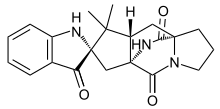Brevianamide
Brevianamides are indole alkaloids that belong to a class of naturally occurring 2,5-diketopiperazines[1] produced as secondary metabolites of fungi in the genus Penicillium and Aspergillus.[2] Structurally similar to paraherquamides, they are a small class compounds that contain a bicyclo[2.2.2]diazoctane ring system.[3] One of the major secondary metabolites in Penicillium spores, they are responsible for inflammatory response in lung cells.[4]
 Brevianamide A | |
 Brevianamide B | |
| Names | |
|---|---|
| IUPAC names
Brevianamide A: (2′R,5aR,8aS,9aR)-8,8-Dimethyl-2,3,8a,9-tetrahydrospiro[5a,9a-(epiminomethano)cyclopenta[f]indolizine-7,2'-indoline]-3',5,10(1H,6H,8H)-trione Brevianamide B: (2′S,5aR,8aS,9aR)-8,8-Dimethyl-2,3,8a,9-tetrahydrospiro[5a,9a-(epiminomethano)cyclopenta[f]indolizine-7,2'-indoline]-3',5,10(1H,6H,8H)-trione | |
| Other names
Brevianamid A; Brevianamid B | |
| Identifiers | |
| |
3D model (JSmol) |
|
| ChemSpider | |
PubChem CID |
|
| UNII | |
| |
| Properties | |
| C21H23N3O3 | |
| Molar mass | 365.433 g·mol−1 |
Except where otherwise noted, data are given for materials in their standard state (at 25 °C [77 °F], 100 kPa). | |
| Infobox references | |
History
Originally isolated from Pennicillum compactum in 1969, brevianamide A has shown insecticidal activity.[2][5] Further studies showed that a minor secondary metabolite, brevianamide B, has an epimeric center at the spiro-indoxyl quaternary center. Both were found to fluoresce under long-wave ultraviolet radiation. Furthermore, under irradaton, brevianamide A has been shown to isomerize to brevianamide B.
Biosynthesis
While the biosynthesis has not been conclusively elucidated, brevianamide A and B are constructed from tryptophan, proline, and an isoprene unit.[6]
Total synthesis
The total synthesis of several brevianamides have been reported, for brevianamide-B [7] and for brevianamide-E.[8][9][10]
Biological activity
Tests for antibiotic effectiveness against E. coli, A. fecalis, B. subtilis, S. aureus, and P. aeruginosa were negative. Also, no inhibitory action was shown against A. niger, A. flavis, P. crustosum, F. graminearum, F. moniliforme, Alternara sp., and Cladosporium sp. However, some insecticidal activity has been shown in one study, possibly showing some use as an insecticide for food crops.[2] In mammalian (mice lung cell) studies, brevianamide A has shown to induce cytoxicity in cells.[4] Furthermore, ELISA assays showed elevated levels of tumor necrosis factor-alpha (TNF-A), macrophage inflammatory protein-2 (MIP-2), and interleukin 6 (IL-6). Therefore, brevianamide A may not be a suitable insecticide in food crops.
See also
References
- Borthwick AD (2012). "2,5-Diketopiperazines: Synthesis, Reactions, Medicinal Chemistry, and Bioactive Natural Products". Chemical Reviews. 112 (7): 3641–3716. doi:10.1021/cr200398y. PMID 22575049.
- Paterson, R. R. M.; Simmonds, M. J. S.; Kemmelmeier, C.; Blaney, W. M. (1990). "Effects of Brevianamide A, its photolysis product brevianamide D, and ochratoxin A from two Penicillium strains on the insect pests Spodoptera frugiperda and Heliothis virescens". Mycol. Res. 94 (4): 538–542. doi:10.1016/S0953-7562(10)80017-6.
- Williams RM, Cox RJ (2003). "Paraherquamides, brevianamides, and asperparalines: laboratory synthesis and biosynthesis. An interim report". Acc. Chem. Res. 36 (2): 127–139. doi:10.1021/ar020229e. PMID 12589698.
- Thomas G. Rand; S. Giles; J. Flemming; J. David Miller & Eva Puniani (2005). "Inflammatory and Cytotoxic Responses in Mouse Lungs Exposed to Purified Toxins from Building Isolated Penicillium brevicompactum Dierckx and P. chrysogenum". Toxicological Sciences. 87 (1): 213–222. doi:10.1093/toxsci/kfi223. PMID 15958659.
- Maiya, S.; Grundmann, A.; Li, S. M. & Turner, G. (2006). "The fumitremorgin gene cluster of Aspergillus fumigatus: identification of a gene encoding brevianamide F synthetase". ChemBioChem. 7 (7): 1062–1069. doi:10.1002/cbic.200600003. PMID 16755625.
- Bringmann G, Lang G, Steffens S, Schaumann K (2004). "Petrosifungins A and B, novel cyclodepsipeptides from a sponge-derived strain of Penicillium brevicompactum". Journal of Natural Products. 67 (3): 311–315. doi:10.1021/np034015x. PMID 15043401.
- Williams, Robert M.; Glinka, Tomasz; Kwast, Ewa; Coffman, Hazel; Stille, James K. (1990). "Asymmetric, stereocontrolled total synthesis of (-)-brevianamide B". Journal of the American Chemical Society. 112 (2): 808–821. doi:10.1021/ja00158a048.
- Schkeryantz, Jeffrey M.; Woo, Jonathan C. G.; Siliphaivanh, Phieng; Depew, Kristopher M.; Danishefsky, Samuel J. (1999). "Total Synthesis of Gypsetin, Deoxybrevianamide E, Brevianamide E, and Tryprostatin B: Novel Constructions of 2,3-Disubstituted Indoles". Journal of the American Chemical Society. 121 (51): 11964–11975. doi:10.1021/ja9925249.
- Kametani, Tetsuji; Kanaya, Naoaki; Ihara, Masataka (1980). "Asymmetric total synthesis of brevianamide E". Journal of the American Chemical Society. 102 (11): 3974–3975. doi:10.1021/ja00531a061.
- Zhao, Liang; May, Jonathan P.; Huang, Jack; Perrin, David M. (2012). "Stereoselective Synthesis of Brevianamide E". Organic Letters. 14: 90–93. doi:10.1021/ol202880y.